Improving employee wellbeing in the workplace has been proven to increase employee engagement, satisfaction, and productivity.
It gives your workforce the confidence to bring their A-game to the table. They are able to address physical and mental health concerns and strike the best balance between their work and home lives.
Read on to discover how you can introduce effective wellbeing initiatives to your company, helping to create a happy and healthy workforce.
What is Employee Well-being?
Employee wellbeing is the overall satisfaction level and health status of staff members. It includes physical and emotional health. It also encompasses economic and mental health.
A number of factors influence employee well-being. These factors include relationships with colleagues and decisions in the organisation. Access to essential tools and resources can also shape well-being.
Employee well-being is also dependent on factors like working hours and pay. It is also dependent on workplace safety. All the factors determining work-life balance can influence employee well-being. Well-being is also influenced by stress at work.
The Importance of Wellbeing at Work
Employee wellbeing is increasingly viewed by leading organisations as crucial to the overall success of the company. In the wake of the pandemic, introducing initiatives to promote the physical and mental health of employees is more important than ever.
The study from the National Center for Biotechnology Information, Well-Being in Life and Well-Being at Work: Which Comes First? summarises the importance of workplace wellbeing as part of a holistic approach to wellbeing, saying:
“We concede that work is just one arena to enhance well-being, however, given the amount of time spent at work across our lifetimes, seemingly a powerful one. Therefore, understanding the well-being ecosystem for impact areas and reciprocal relationships in life and at work is important to finding ways to intervene. Without this holistic view, the leverage points for optimizing well-being may be invisible or inadequate by an overemphasis or attribution to one sphere of influence only.”
As an employer, you can have a limited impact on factors that influence wellbeing outside of the workplace. However, there is a range of avenues you can explore to encourage workplace wellbeing.
Additionally, approaches can be taken to help employees who are working remotely to improve their overall health and wellbeing.
This article will consider a range of methods that can be adopted in the workplace to help encourage an environment where wellbeing is prioritised. This includes:
- How to promote health and wellbeing in the workplace
- How to improve levels of wellbeing throughout your workforce
- What benefits employees – and the company – can expect from an effective wellbeing strategy
- Ideas you can try yourself which promote health and wellbeing
The 5 Pillars of Employee Wellbeing
Want to shape the right mindset and skills in employees? Then you must emphasise the five main pillars of employee well-being. You will be able to foster a positive work culture in the workplace. Here are the five key pillars.
Pillar 1- Physical Wellbeing
Physical well-being is about physiological health. Work environment and physical fitness can shape it. Healthy habits like nutrition choices also influence physical well-being. So think about what snacks to place in the vending machines.
Affordable, healthy food choices at the cafeteria can promote physical well-being. Opportunities for physical activities through walking breaks and standing desks also help. Safety training and on-site health resources can further improve physical well-being.
Pillar 2- Emotional Wellbeing
Emotional well-being is about the mental health of your employees. It is defined by one’s mental and emotional health at work. Social support and work-life balance can support the emotional well-being of employees. Stress management practices also lead to positive emotions.
Employee assistance programs can help promote emotional well-being. Counselling services go into such programs. Flexible work arrangements also help reduce stress. Social events and team-building exercises can be arranged to foster social support.
Pillar 3- Social Wellbeing
Social well-being is about interactions and interpersonal relationships at work. It is shaped by trust and respect. It is also shaped by cohesion between team members.
Employers promote the social well-being of employees by facilitating social interactions at work. Employers also create volunteering opportunities. They also create social events to let employees connect with each other outside of work.
Pillar 4- Financial Wellbeing
Financial well-being is about the economic safety of staff members. Organisations try to help employees save and manage money to promote financial wellbeing. The employers arrange seminars and workshops for the financial education of employees.
Employers try to offer financial benefits like health insurance coverage and pension plans. Companies also try to dispatch the correct salary amount on time to promote the financial well-being of employees.
Pillar 5- Career Wellbeing
Career wellbeing is about promoting employees and advancing their careers. It is about one’s feelings towards career growth opportunities. Employers try to arrange training and mentoring programs to help employees gain new skills.
Internal promotions contribute greatly to overall wellbeing. So, employees must have sufficient opportunities to move up the ladder. Career wellbeing can also be about having the skills to dominate hiring rounds in almost every company.
On the same note, job satisfaction is crucial to employee engagement and retention. Along with growth measures, active steps to perpetuate work-life balance like flexible schedules can also improve career wellbeing. Reduced hours of work also prevent burnout and promote career wellbeing.
How Can Poor Well-being Affect Employees?
Why is well-being important in the workplace? Work-related illness is endured by around 1.7 million employees in Great Britain. Poor well-being makes staying focused and productive at work difficult.
Poor Physical Wellbeing Leads To
- Absenteeism: Minor illnesses like the common cold result in 33 million lost work days annually on average in the UK. Absent employees translates to delayed task completion, productivity loss, and increased stress on those present.
- Lost Productivity: Employees who are sick often fail to be as productive as during fit conditions. This leads to a loss of employee productivity. Over time, the productivity loss becomes expensive.
Poor Mental Wellbeing Leads To
- Absenteeism: Poor mental health results in a loss of 18 million work days annually on average in the UK. Absence of these employees from work leads to work getting lined up. It delays project delivery and increases stress on present employees.
- Lost Productivity: Employees battling a falling mental health struggle to focus on tasks. Mental health issues also overwhelm and distract employees. So, it leads to productivity loss. It can also potentially lead to quality issues or errors in tasks.
Poor Financial Wellbeing Leads To
- Decreased Motivation: Employees who are not satisfied with the pay are likely to be less motivated at work. Employees lacking motivation can be less productive. They may also deliver tasks with compromised quality.
- Employee Turnover: Employees who don’t feel that their job is paying enough are expected to quit soon. Such employees will try to find and pursue opportunities they think are worth the effort.
Poor Social Wellbeing Leads To
- Decreased Satisfaction: Employees won’t be satisfied in a workplace with poor relationships with co-workers. Dissatisfied employees lose motivation. They become less productive. Poor interpersonal relationships also affect team cohesion.
Poor Career Wellbeing Leads To
- Employee Turnover: Employees would switch to a different organisation if they don’t sense a growing career. Employee turnover can be costly. It leads to new hiring and employee development costs.
Promoting Health and Wellbeing at Work
There are a variety of communication strategies businesses can adopt in order to promote health and wellbeing at work. By using a multi-channel communications platform, you can ensure these promotions reach everyone, including remote working staff who otherwise might feel out of the loop.
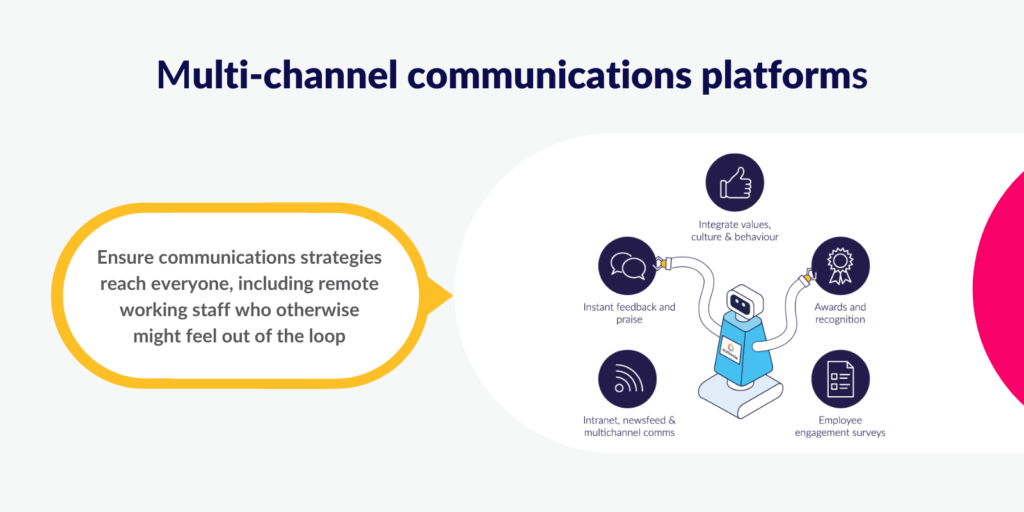
Try some of these ideas to better promote health and wellbeing at work:
Exercise and Fitness Class Promotions
Exercise and fitness classes are an obvious way to help employees improve their physical and mental health. It’s easy to promote these in the workplace. You can use your company’s forums to set up notice boards for a range of classes, encouraging employees to share suggestions too. This could include anything from break time yoga sessions to lunchtime walks or bike rides. You can also help to initiate activities that can take place outside of the workplace, over weekends or in the evenings.
Awards and Recognition Programs
Recognition for a job well done encourages employees to improve their performance and can be enhanced through awards and recognition programs. Some performance management software allows users to rate one another’s performance. Whether they’ve delivered a solid presentation or completed an assignment to a high standard, their coworkers can show appreciation.
Use these awards and recognition programs to create a constant flow of positive feedback within teams, departments, and the wider workforce.
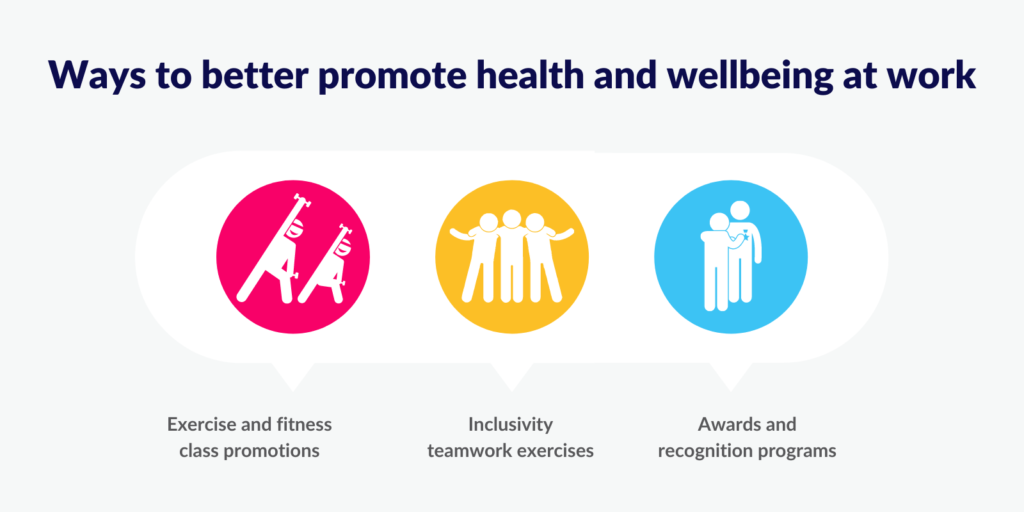
Inclusivity Teamwork Exercises
When an employee feels disconnected from their colleagues, their wellbeing is likely to be affected. Positive team dynamics, in which each member feels included, is an essential component of employee wellbeing.
In an interview with Forbes magazine, Michael Fenlon, Chief People Officer, at PwC, observed how teamwork plays into wellbeing initiatives:
“One of the things we’ve learned from doing this work is don’t go at it alone. In other words, the magic resides in teams, in creating that sense of community. So yes, while we are providing information to individuals and asking people to opt-in and build their own personal plan, really the power resides when we’re doing this socially in teams.”
There are a range of team-building exercises you can set up to help promote this sense of community and promote a healthy level of inclusion in the workforce.

How Can We Improve Wellbeing in the Workplace?
There are several approaches business leaders can take to help improve wellbeing in the workplace. Consider adopting the following measures:
Encourage Employees to Discuss Their Concerns
One of the biggest problems many have with addressing health and wellbeing issues is the inability to face up to them. Employees who are feeling anxious or depressed often keep this to themselves, when they could benefit from frank and open discussions about their problems.
Encouraging your workforce to speak openly about issues is the first step to addressing them. This could be a conversation with their team leader or manager, or it could be a meeting with the company’s occupational health representative. Put measures in place so that your employees have someone to talk to should they feel the need.
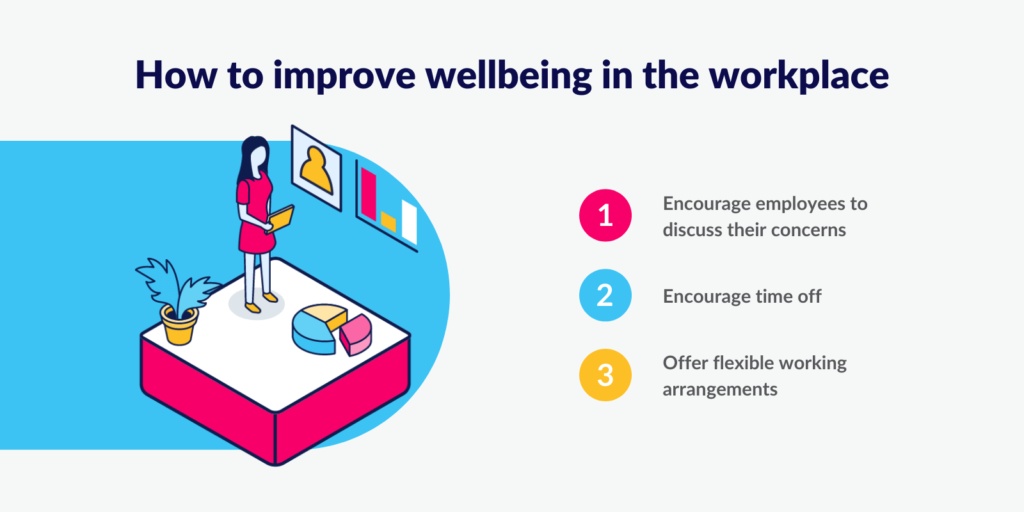
Encourage Time Off
Employees, especially those who are driven to perform highly, can avoid taking time off work. As a result, they can experience burnout. Make the effort to encourage staff who may class themselves as ‘workaholics’ to take more time off to relax and recuperate. Your HR team can help managers identify those who take infrequent holidays through their absence management software. You can then encourage those who are overworked to take time away to help them maintain a positive work/life balance.
Offer Flexible Working Arrangements
Stress can come from a variety of sources. Employees may not have enough time to do the morning school run or need a flexible work arrangement to help look after a family member. You can help with these problems by offering flexible working arrangements. This allows your employees to improve their schedule, decreasing their stress and improving wellbeing.
How Neuroscience Helps in Understanding Wellbeing
Let’s understand the importance of well-being at work from the perspective of neuroscience.
Psychological Health
Everyone wants to live happily. But happiness depends on how satisfied one is with their life. Work dictates a significant proportion of satisfaction among people. People face their co-workers every day at work. So, poor interpersonal relationships can affect the mental health of employees. It also impacts emotional well-being.
Psychological health is also influenced by work-life balance. It determines the time and energy employees can spend on personal goals and relaxation. Career growth opportunities also shape how secure employees feel when committing to an organisation.
Physiological Health
Staying fit is a basic need for people. Being healthy allows working hard and performing better. So, you must focus on aspects like nutrition and physical activity of employees.
Work-life balance can also impact physical health. It can determine the level of stress experienced by employees. It also determines the exposure of employees to workplace risks. This is particularly applicable for those involved in potentially hazardous tasks.
Theoretical Perspective
Looking for ideas for wellbeing at work? Satisfying employees requires eliminating factors that dissatisfy them. Dissatisfiers can be factors like untimely pay or negative supervision. Once the dissatisfiers are removed, employees can be motivated with motivating factors.
The motivators can be factors like performance rewards and recognition. This is what Herzberg’s Motivation-Hygiene Theory holds. So, efforts towards employee wellbeing can help organisations remove dissatisfiers and introduce motivators.
What Are the Benefits of a Wellbeing Strategy?
An effective wellbeing strategy can help your employees overcome challenges in their personal and professional lives. This motivates them to perform at their best, giving them confidence in the company’s understanding of their physical and mental health.
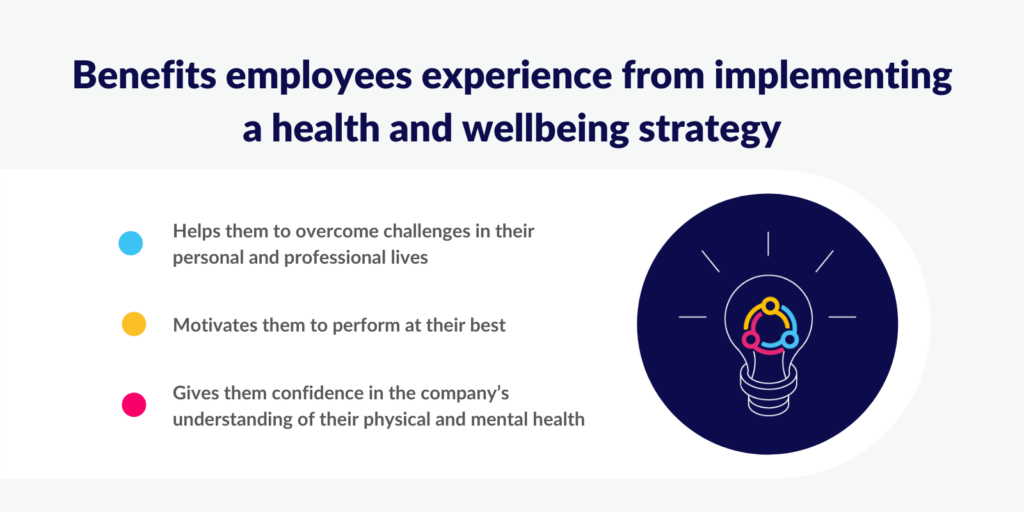
The benefits of a comprehensive wellbeing strategy aren’t limited to your employees. Benefits also impact the company at large, improving outcomes across a series of key metrics.
The detailed study of wellbeing in the workplace from Gallup, Wellbeing in the Workplace and Its Relationship To Business Outcomes, observes:
“The ability to promote well-being rather than engender strains and mental illness is of considerable benefit not only to employees in the community but also to the employer’s bottom line. The emotional well-being of employees and their satisfaction with their work and workplace affect citizenship at work, turnover rates, and performance ratings.”
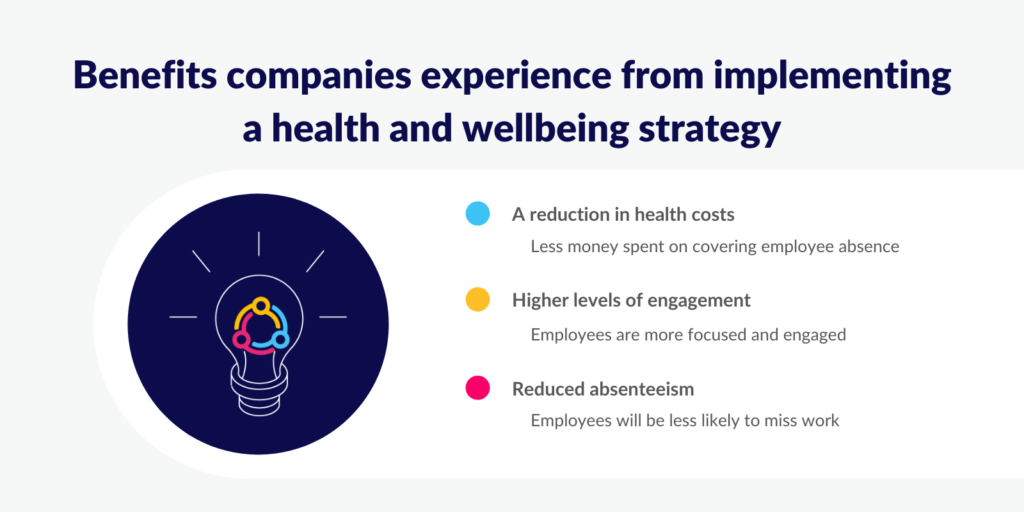
Other benefits companies can experience from a health and wellbeing strategy include:
- A reduction in health costs. Fewer members of staff taking time off to address physical and mental health concerns means less money spent on covering their absence
- Higher levels of engagement. Employees who are satisfied with their level of wellbeing are more focused on performing well and engaging positively with their work
- Reduced absenteeism. Employees will take fewer sick days and be less likely to miss work. A happy and healthy workforce enjoys participating in projects and work activities.
Additional Benefits
Still wondering why is wellbeing important? Here are the additional benefits of prioritising employee wellbeing.
Increased Employee Retention
Employees who are satisfied with their jobs are less likely to quit, even if better pay is offered. Not every employee prioritises pay. Employees want to work for an organisation that doesn’t make earning more difficult than it should be.
Many employees would prefer working for an organisation that offers good pay and work environment, rather than in one that promises higher pay but has a negative working environment. Over 55% of employees value a strong workplace culture more than the pay.
Stronger Employer Brand
Strong employee wellbeing practices can position your organisation as a favourable employer brand. Talented candidates prefer to work in organisations that care about their well-being. This will also make it easy to hire the right skills.
Higher Employee Productivity Level
Employee well-being practices lead to higher levels of satisfaction and motivation. As a result, productivity in your organisation will increase. Motivated employees are also likely to deliver higher-quality work on time.
Health and Wellbeing at Work Ideas
Here are some additional workplace health and wellbeing ideas you can implement to address employee wellbeing and build a happy and healthy workforce:
- Provide healthy snacks for employees
- Arrange a walking meeting
- Encourage colleagues to meet up informally
- Provide company perks that contribute to wellbeing
- Introduce company-wide meetings
- Start volunteering initiatives
- Resilience training sessions for improving personal development
- Introduce regular social events, such as Friday evening drinks or company lunches
- Engage with the local community
- Offer employees discounts for local gym memberships
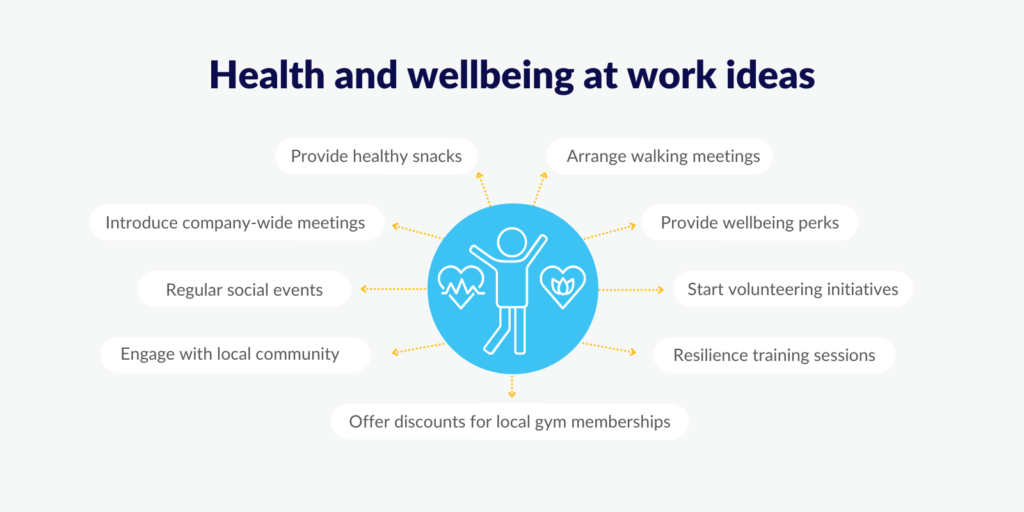
Conclusion
Employee well-being practices can help you satisfy and motivate employees. So, productivity and quality of work in your organisation will improve. Fulfilled employees are also least expected to resign. So, issues related to employee turnover can also be addressed. Employee well-being practices improve teamwork and collaboration, too.
Remember that employee wellbeing strategies go beyond mental and physical wellbeing. It is also about making employees feel financially secure. It is also about ensuring employees have career growth opportunities. It is also about promoting positive emotions among people.
Ensure work-life balance. Guarantee proper pay. Facilitate good interpersonal relationships. And arrange skill development programs. All these approaches contribute to employee well-being.
Frequently Asked Questions
How Do I Start Employee Wellbeing Practices in My Organisation?
To do this, you must promote work-life balance. Create flexible schedules. Focus on strengthening relationships between people in your organisation. Ensure that you are offering proper pay and on time. Make sure there are arrangements in place to develop employee skills and make them future-ready. Also, create fair employee appraisal policies. Ensure that your reward and bonus policies are fair as well.
Will Employee Well-being Practices Increase Operating Costs?
Your operating cost may increase if you increase the basic wage or arrange development programs. Employee well-being practices are guaranteed to deliver a high return on investment if done right. The increased productivity comes from motivated employees. The reduced turnover is due to satisfied employees, which will result in a positive brand reputation. All these benefits will offset any increased operating cost with higher revenues. A spend of £1500 on employee development can result in a 24% higher annual profit.
Are There Systems or Tools Available for Employee Well-being Management?
Yes, you will find different systems to help you with employee well-being practices. You can implement performance management tools to understand skill gaps and design employee development programs accordingly. You can also use systems dedicated to employee development and engagement tasks. Analytics tools also help with employee well-being management by displaying various useful insights in real time. These insights can be used to design a number of employee wellbeing initiatives.





